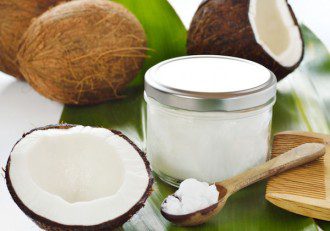By Marie Be
Guest Writer for Wake Up World
The largest organ of the body, the skin, begins its complex process of development about a week after conception, and continues to evolve throughout pregnancy and following birth. Proper skin care during the first year of an infant can positively affect the full term development of the skin, as well as enhance a child’s overall developmental health. Sadly, with the propaganda from the cosmetic industry, we’ve lost fundamental knowledge on how to properly take care of the skin of a baby.
Many baby products have been associated with systemic toxicity. This is in part due to the fact that the cosmetic industry created the misconception that the skin is impervious, and regulations misleadingly classify skin care products as ‘external’ products (1) – ignoring the effects of dermal chemical absorption. Baby products do not escape this lack of safety and therefore contain a smogboard of toxic chemicals. (check out : The Cosmetic Industry; A History of Subsidies, Under-Regulation and Propaganda)
The most basic skin function, the barrier function, is not fully developed in infants. This means baby’s skin is a potential portal of entry for hazardous toxic chemicals. There is a direct correlation between young age and toxin absorption, simply because of the higher skin surface area to weight ratio in infants.
Risks from cutaneous exposure to cosmetic chemicals may differ between children and adults for a variety of reasons, including anatomic and physiologic differences in absorption and metabolism, and developmental differences of vital organs (2). Infant skin is still underdeveloped and more fragile than an adult’s skin:
- The full thickness of a newborn’s skin is considered to be 40-60% that of adult skin (3). Baby skin is therefore more absorbent than adult skin. This means that chemicals and pollutants have an easier way at making their way into baby’s fragile body.
- Infant skin both absorbs and loses moisture more quickly than adult skin. With a greater exchange rate, external irritants penetrate infant skin more easily (4).
- Baby skin contains a higher lipid content, which makes it easier for fat-soluble substances to pass through the skin (5). Most cosmetic products are fat-soluble.
The effect of systemic chemical absorption are also greater in infants and babies:
- Children have a greater skin to body size ratio than adults. This means they absorb more toxins per body weight (6).
- Babies do not have fully effective detoxification systems, which means that damages from exposure are increased. For the first year of its life, an infant’s kidney’s filtration rate is a fraction of adult values (7). Since kidneys are the principal pathway for elimination of most chemicals from the body, infants are therefore more susceptible to bio-accumulation.
- Infants are growing and developing at an accelerated rate. The effect of toxins on growing tissues and organs, and developing immune, endocrine and nervous systems is greater.
- Children have immature blood-brain barriers and enhanced central nervous system (CNS) receptivity (8). This means toxins encounter less resistance while traveling through the body and can easily access sensitive areas such as the brain.
Toxicant absorption from skin care products has many detrimental effects on the overall growth and development of a child. (see: Toxic Babies) Propaganda from the cosmetic industry has been going on for at least a century, and misinformation is now part of the “common knowledge”. (For more information, please see: Skin Science – Debunking Cosmetic Industry Propaganda.)
Here Are Some Tips On How to Naturally Take Care of Your Infant’s Skin
During the last trimester of pregnancy, a layer of vernix grows on baby’s skin to protect it from bacteria and amniotic fluid (8). Babies are covered in vernix when they are born. Hospital protocol calls for immediate washing of the vernix, which needs to be scrubbed off. Vernix is a natural skin cleanser and moisturiser, with anti-infective, anti-oxidant and wound-healing properties. It is meant to protect baby’s skin against potential infection, acidification and transepidermal water loss (9). Vernix should not be removed immediately following birth, but allowed to fall off naturally and its beneficial elements absorbed into the skin (10).

During the first weeks of life, frequent bathing is neither suitable nor beneficial. Babies only need bathing about every four days. Frequent bathing can adversely affect the maturation of the skin, cause potential irritations, pH changes or chemical absorption (11). Use of conventional toiletries, soap or wipes , even labeled “for baby”, should be avoided at all cost. Synthetic toiletry products commonly used for neonatal skin care contain chemicals which may affect skin maturation and be absorbed into baby’s fragile body (12-13).
Effective nappy care should prevent damage to the developing stratum corneum. Nappy rash can be reduced if nappies are changed frequently during the day and at least once during the night, with the baby being nursed with skin exposed as often as possible (14). The nappy area should be cleaned using water only. It can be beneficial to protect the stratum corneum from rashes and irritation due to contact with urine and faeces. Many diaper ointments contain zinc to produce a protective barrier between the skin and the content of the diaper. While zinc is an effective protective barrier, baby’s thin skin and large pores have the potential to absorb the substance into the body, increasing systemic toxicity (15)
Another effective way to protect the skin from rashes is to absorb the bacteria with zeolite clay. In the complete absence of bacteria, rashes cannot develop. Zeolite works best in conjunction with cacao butter, which prevents the skin from absorbing too much moisture and becoming sensitive. (Check out CocoBum from EarthSun for a natural product that combines zeolite and cacoa butter.)
Children’s skin might need to be moisturized. Make sure he or she drinks plenty of water, as it has a direct effect on skin texture and health. An effective skin moisturizer for dry skin is simply virgin coconut oil or cacao butter (16). Applying anything that is not eatable on an child’s skin only increases toxic absorption.
When unsure, ask yourself — What your great-grandma would have used? Nature always provided what we need to make our bodies healthy and take care of our skin – we just have forgotten!
Article sources:
- The Story of Cosmetics. www.safecosmetics.org/SoCos_footnoted_script
- Siegfried E., Shah P. Neonatal skin and skin care. Dermatol Clin 1998; 16: 437-46.
- Vebrov J. Common skin conditions in the newborn. Seminars Neonatol 2000; 5: 303-10.
- Bearer, “How Are Children Different from Adults?”
- Hoeger P. Physiology of Neonatal Skin. Chapter 1.2 p42. In: Harper J., Oranje A., Prose N., eds. Textbook of Pediatric Dermatology, Vol 2. Blackwell Publishing. 2006. 1.2:42.
- Plunkett, L. et al., “Differences Between Adults and Children Affecting Exposure Assessment,” Similarities and Differences Between Children and Adults: Implications for Risk Assessment, International Life Sciences Institute, 1992, pp. 79-94.
- Principles for Evaluating Health Risks From Chemicals During Infancy and Early Childhood.
- Plunkett, L. et al., “Differences Between Adults and Children Affecting Exposure Assessment,” Similarities and Differences Between Children and Adults: Implications for Risk Assessment, International Life Sciences Institute, 1992, pp. 79-94.
- Hoeger P. Physiology of Neonatal Skin. Chapter 1.2 p42. In: Harper J., Oranje A., Prose N., eds. Textbook of Pediatric Dermatology, Vol 2. Blackwell Publishing. 2006. 1.2:42.
- Visscher M.O., Narendran V., Pickens W. et al. Vernix caseosa in neonatal adaptation. J Perinatol 2005; 25: 440-46.
- World Health Organisation. Pregnancy, Childbirth, Postpartum and Newborn Care. 2003. Available at http://hetv.org/resources/reproductive-health/pcpnc.pdf
- Lambe M. Topical agents in infants. Newborn Infant Nurs Rev 2001; 1(1): 25-34.
- ***Medves J., O’Brien B. Does bathing newborns remove potentially harmful pathogens from the skin? Birth 2001; 28(3): 161-65.
- Spray A., Siegfried E. Dermatologic toxicology in children. Pediatric Annals 2001; 30(4): 197-202.
- Borkowski S. Diaper rash care and management. Pediatric Nurs 2004; 30(6): 467-70.
- Gupta A.K., Skinner A.R. Management of diaper dermatitis. Int J Dermatol 2004; 43(11): 830-40.
- Atherton D., Mills K. What can be done to keep babies skin healthy? Midwives 2004; 7(7): 288-90.
Previous articles by Marie Be:
- How GMO Foods Turn Your Intestines Into a Pesticide Factory
- How to Detox the Body of Heavy Metals and Avoid Common Exposures
- Preventative Detox: 6 Foods to Avoid for a Clean Healthy Body
- BURN: Health Impacts of Sunscreen Found to be Worse Than UV Damage!
- Natural Detox : Flush Your Toxins Down the Drain
- Easy Home Recipe: Skin and Body Detox Cream
- Skin Science – Debunking Cosmetic Industry Propaganda
- 3 Years After Fukushima: Behind the Skewed Data and Vested Interests
- How Modern Symptom-Based Medicine Can Make the Sick, Sicker
- Heavy Metal Toxicity Can Ruin Your Health
About the author:
 Marie Be’s inspiration comes from her mom who always challenged common assumptions and sought to understand for herself the major issues concerning her family and the choices she made on their behalf. She raised Marie and her brother in a rural environment, feeding them the best organic foods, and focused on building strong immune systems in her children through the use of natural plants, herbs and minerals.
Marie Be’s inspiration comes from her mom who always challenged common assumptions and sought to understand for herself the major issues concerning her family and the choices she made on their behalf. She raised Marie and her brother in a rural environment, feeding them the best organic foods, and focused on building strong immune systems in her children through the use of natural plants, herbs and minerals.
As a fiery teenager, Marie travelled the world in search of purpose and dreamed of positively influencing our society. While earning her first two degrees, in architecture and sustainable development, she worked for Greenpeace and many other organizations of change. Her experience taught her that change cannot be imposed; she now aims at inspiring individuals through education and awareness.
Marie moved to Vancouver to undertake a Masters in Regenerative Sustainability under the supervision of a Nobel Peace Prize recipient. Teaching workshops on well-being, she started observing a widespread desire in our society for both physical and environmental health and sustainability. Feeling the winds of change, Marie founded Earth for the Sun.
Earth for the Sun was inspired by nature, the source of life. By tuning in that source, by acquiring knowledge on ancient herbal traditions as well as new technologies, Marie believes it is possible to use nature’s intelligence and deliver simple and effective health products.
Check out Earth For The Sun for more information, or connect with Marie Be on Facebook and Google Plus.

If you've ever found value in our articles, we'd greatly appreciate your support by purchasing Mindful Meditation Techniques for Kids - A Practical Guide for Adults to Empower Kids with the Gift of Inner Peace and Resilience for Life.
In the spirit of mindfulness, we encourage you to choose the paperback version. Delve into its pages away from screen glare and notifications, allowing yourself to fully immerse in the transformative practices within. The physical book enriches the learning process and serves as a tangible commitment to mindfulness, easily shared among family and friends.
Over the past few years, Wake Up World has faced significant online censorship, impacting our financial ability to stay online. Instead of soliciting donations, we're exploring win-win solutions with our readers to remain financially viable. Moving into book publishing, we hope to secure ongoing funds to continue our mission. With over 8,500 articles published in the past 13 years, we are committed to keeping our content free and accessible to everyone, without resorting to a paywall.







